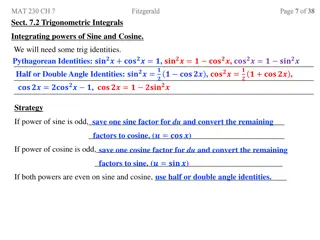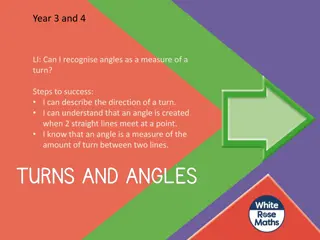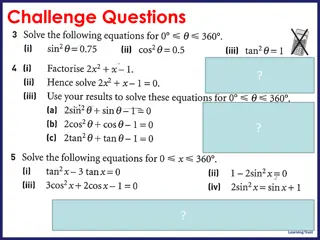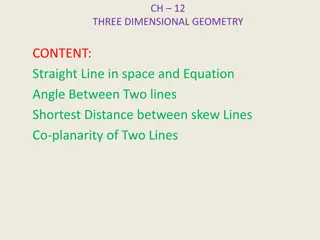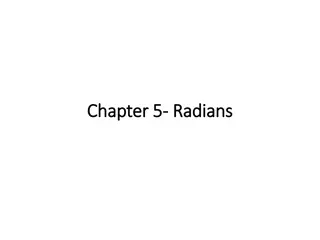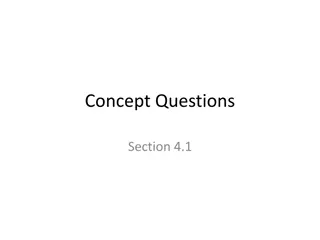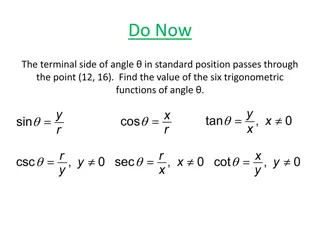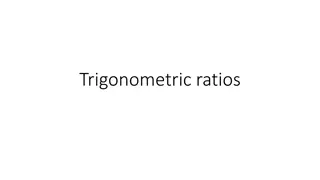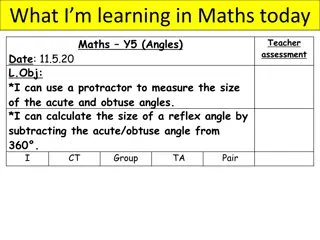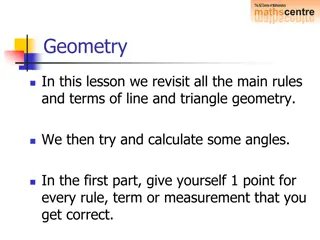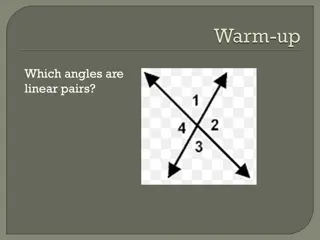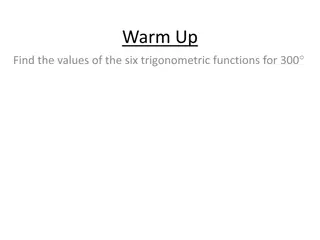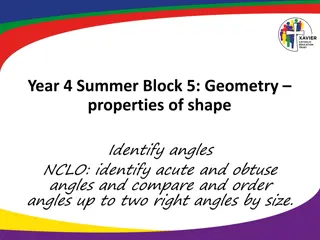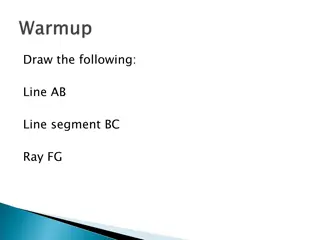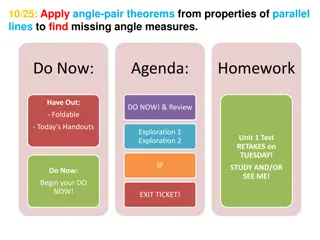Understanding Trigonometric Identities for Double Angles
Special identities like the Pythagorean identity and double angle identities for sine and cosine are explored in this content. The Pythagorean identity states that cosine squared plus sine squared equals one, while the double angle identities provide formulas for cosine of double angles. Through the use of these identities, various relationships between trigonometric functions can be derived and utilized to solve problems effectively.
Download Presentation

Please find below an Image/Link to download the presentation.
The content on the website is provided AS IS for your information and personal use only. It may not be sold, licensed, or shared on other websites without obtaining consent from the author. Download presentation by click this link. If you encounter any issues during the download, it is possible that the publisher has removed the file from their server.
E N D
Presentation Transcript
28 September 2024 Trigonometric identities LO: To find the Pythagorean identity and trigonometric identities for the sine and cosine of the double angle. To use those identities to solve problems. www.mathssupport.org www.mathssupport.org
Pythagorean identity In this section we are going to look at special kinds of equations called identities y From the unit circle we found that: OC = cos BC = sin sin = y cos = x (cos sin ) B 1 sin Since it is a right angled triangle we can use Pythagoras theorem and say that (cos ) + (sin )2 = 1 cos + sin = 1 This called The Pythagorean identity A C 0 x cos We can also say that sin Another identity tan = cos www.mathssupport.org www.mathssupport.org
Double angle identity for cosine In the following diagram, we draw the reflection of the angle in the fourth quadrant. The length AC A 1 We can see that the angle AOB = 2 sin y = BC = sin So, AB = AC + BC = 2sin sin C O x The length AB can be found using the cosine rule in the AOB. Squaring both sides 4sin2 = 2 - 2cos(2 ) Rearranging 2cos(2 ) = 2 - 4sin2 Dividing by 2 cos(2 ) = 1 - 2sin2 1 B AB2 = AO2 + BO2 2(AO)(BO)cos(2 ) AB2 = 12 + 12 2(1)(1)cos(2 ) AB = 2 2cos(2?) Now we have two expressions for AB 2sin = 2 2cos(2?) This is one identity for the cosine of the double angle www.mathssupport.org www.mathssupport.org
Double angle identity for cosine We are going to use this identity to find more identities for the cosine of the double angle cos(2 ) = 1 - 2sin2 We will use the Pythagorean identity cos + sin = 1 Rearranging the identity Substituting in the identity sin = 1 cos cos(2 ) = 1 2(1 cos ) Expanding brackets Simplifying and rearranging This is another identity for the cosine of the double angle cos(2 ) = 1 2 + 2cos cos(2 ) = 2cos 1 www.mathssupport.org www.mathssupport.org
Double angle identity for cosine We are going to use this last identity to find more identities for the cosine of the double angle cos(2 ) = 2cos 1 We will use the Pythagorean identity cos + sin = 1 We can substitute the identity into the identity cos(2 ) = 2cos (cos + sin ) Expanding brackets cos(2 ) = 2cos cos sin Simplifying cos(2 ) = cos sin This is another identity for the cosine of the double angle www.mathssupport.org www.mathssupport.org
Double angle identity for sine Now we are going to find a double-angle identity for sine We will use the Pythagorean identity cos (2 )+ sin (2 ) = 1 Rearranging cos (2 )= 1 sin (2 ) From the double angle identity for cosine cos + sin = 1 We can say cos(2 ) = 1 - 2sin2 cos (2 ) = (1 - 2sin2 ) cos (2 ) = 1 - 4sin2 + 4sin4 1 sin (2 )= 1 4sin2 + 4sin4 =sin (2 ) 4sin2 4sin4 =sin (2 ) 4sin2 (1 sin2 ) =sin (2 ) 4sin2 cos2 2sin cos Squaring both sides Equating these equations Simplifying Factorising Substituting from Taking square root of both sides 1 sin2 =sin(2 ) www.mathssupport.org www.mathssupport.org
Summary of identities sin tan = cos Pythagorean identity cos + sin = 1 Double angle identities for cosine cos(2 ) = 1 2sin2 cos(2 ) = 2cos 1 cos(2 ) =cos sin Double angle identity for sine sin(2 ) = 2sin cos www.mathssupport.org www.mathssupport.org
Using identities sin =3 4, and 0o< < 90o Given that Find the exact values of (a) cos Solution: Using the Pythagorean identity cos + sin = 1 Substituting the value of sine 2= 1 3 4 cos + Rearranging and simplifying 9 cos = 1 16 cos = 7 16 Taking square root of both sides 7 cos = 4 www.mathssupport.org www.mathssupport.org
7 Using identities cos = 4 sin =3 4, and 0o< < 90o (b) sin(2 ) Given that Find the exact values of Solution: Using the double angle identity for sine sin(2 )= 2sin cos Substituting the value of sin and cos sin(2 ) = 2 3 4 7 4 Simplifying 6 7 16 sin(2 ) = sin(2 ) = 3 7 8 www.mathssupport.org www.mathssupport.org
7 Using identities cos = 4 sin =3 sin(2 )= 3 7 4, and 0o< < 90o (c) cos(2 ) Given that 8 Find the exact values of Solution: Using a double angle identity for cosine cos(2 ) = 1 2sin2 Substituting the value of sin 2 3 4 cos(2 ) = 1 2 Simplifying 9 cos(2 ) = 1 2 16 9 8 cos(2 ) = 1 cos(2 ) = 1 8 www.mathssupport.org www.mathssupport.org
7 Using identities cos = 4 sin =3 sin(2 )= 3 7 cos(2 ) = 1 4, and 0o< < 90o (d) tan(2 ) Given that 8 Find the exact values of Solution: 8 Using identity of tangent sin tan = cos sin(2 ) Changing by 2 tan(2 )= 3 7 8 cos(2 ) tan(2 )= Substituting sin(2 )and cos(2 ) 1 8 tan(2 )=3 7 Simplifying 8 8 1 tan(2 )= 3 7 www.mathssupport.org www.mathssupport.org
Using identities when working with equations Solve the equation Do not use GDC Solution: for 0o x 360o sin2x = sin x Using the double angle identity for sine sin(2 )= 2sin cos 2(sin x)(cos x)= sin x 2(sin x)(cos x) sin x = (sin x)(2cos x 1)= (sin x) = If sin x = Then x = If 2cos x 1 = Then cos x =1 Then x = Replacing sin 2x Rearranging Factorising or Using the null factor law (2cos x 1)= 2So x = www.mathssupport.org www.mathssupport.org
Thank you for using resources from A close up of a cage Description automatically generated For more resources visit our website https://www.mathssupport.org If you have a special request, drop us an email info@mathssupport.org www.mathssupport.org www.mathssupport.org


